Sustainability Assessment and Wicked Problems
VerifiedAdded on 2020/03/01
|11
|3052
|13
AI Summary
This assignment delves into the intricacies of sustainability science, particularly focusing on the concept of wicked problems and their implications for policy and management. It examines best practices in corporate social responsibility, explores various sustainability assessment frameworks, and analyzes the interconnected nature of global sustainability challenges. Students are tasked with critically evaluating scholarly sources and synthesizing information to understand the complexities surrounding sustainable development.
Contribute Materials
Your contribution can guide someone’s learning journey. Share your
documents today.
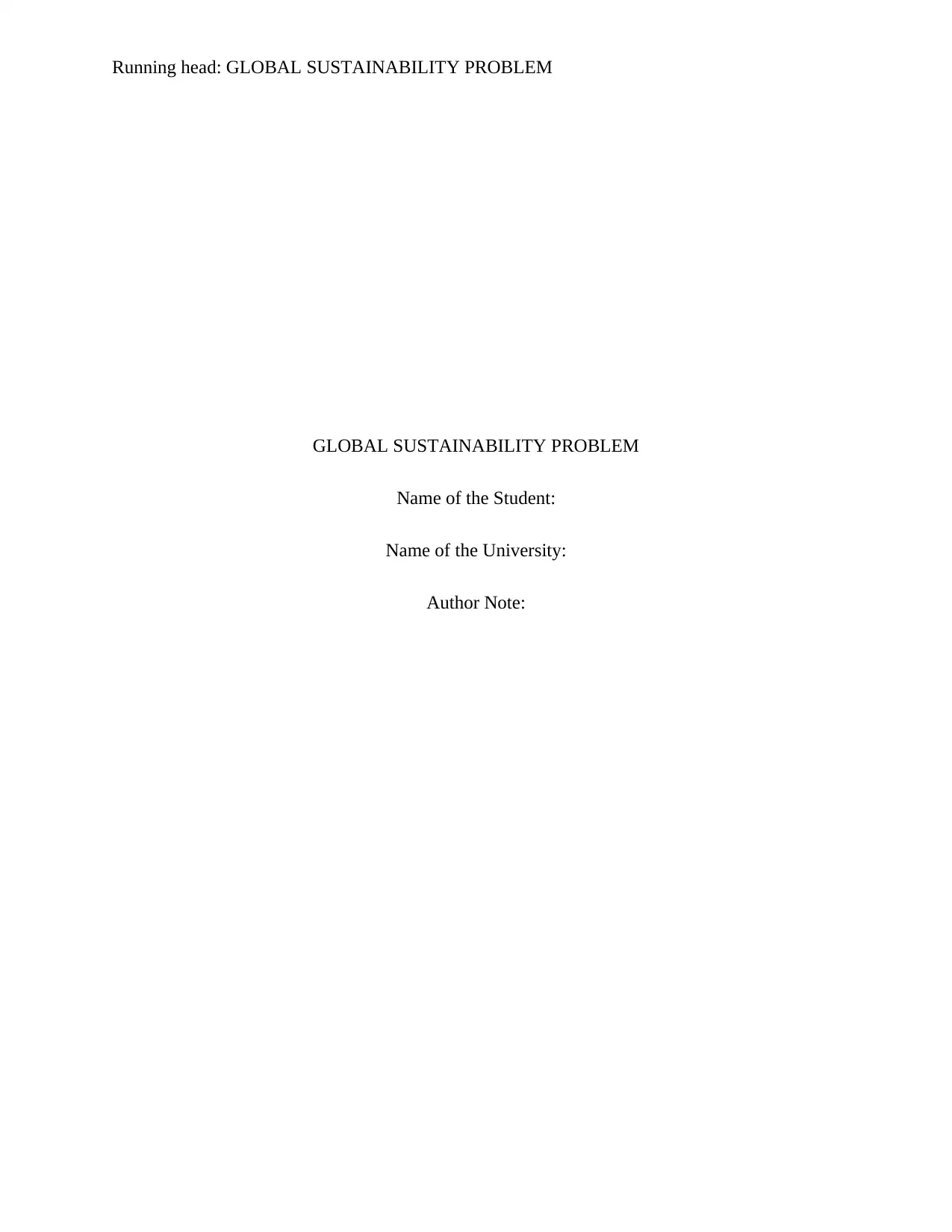
Running head: GLOBAL SUSTAINABILITY PROBLEM
GLOBAL SUSTAINABILITY PROBLEM
Name of the Student:
Name of the University:
Author Note:
GLOBAL SUSTAINABILITY PROBLEM
Name of the Student:
Name of the University:
Author Note:
Secure Best Marks with AI Grader
Need help grading? Try our AI Grader for instant feedback on your assignments.
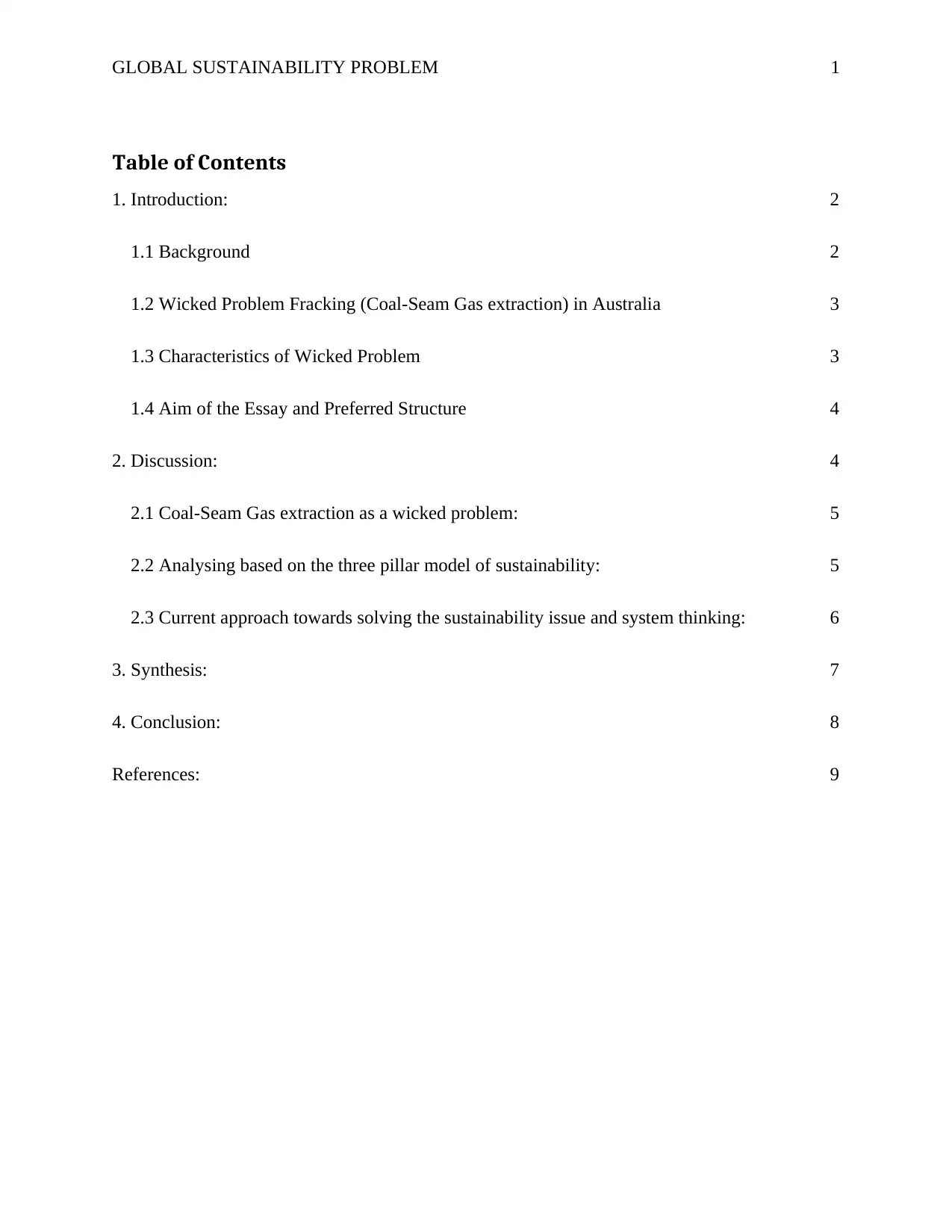
GLOBAL SUSTAINABILITY PROBLEM 1
Table of Contents
1. Introduction: 2
1.1 Background 2
1.2 Wicked Problem Fracking (Coal-Seam Gas extraction) in Australia 3
1.3 Characteristics of Wicked Problem 3
1.4 Aim of the Essay and Preferred Structure 4
2. Discussion: 4
2.1 Coal-Seam Gas extraction as a wicked problem: 5
2.2 Analysing based on the three pillar model of sustainability: 5
2.3 Current approach towards solving the sustainability issue and system thinking: 6
3. Synthesis: 7
4. Conclusion: 8
References: 9
Table of Contents
1. Introduction: 2
1.1 Background 2
1.2 Wicked Problem Fracking (Coal-Seam Gas extraction) in Australia 3
1.3 Characteristics of Wicked Problem 3
1.4 Aim of the Essay and Preferred Structure 4
2. Discussion: 4
2.1 Coal-Seam Gas extraction as a wicked problem: 5
2.2 Analysing based on the three pillar model of sustainability: 5
2.3 Current approach towards solving the sustainability issue and system thinking: 6
3. Synthesis: 7
4. Conclusion: 8
References: 9
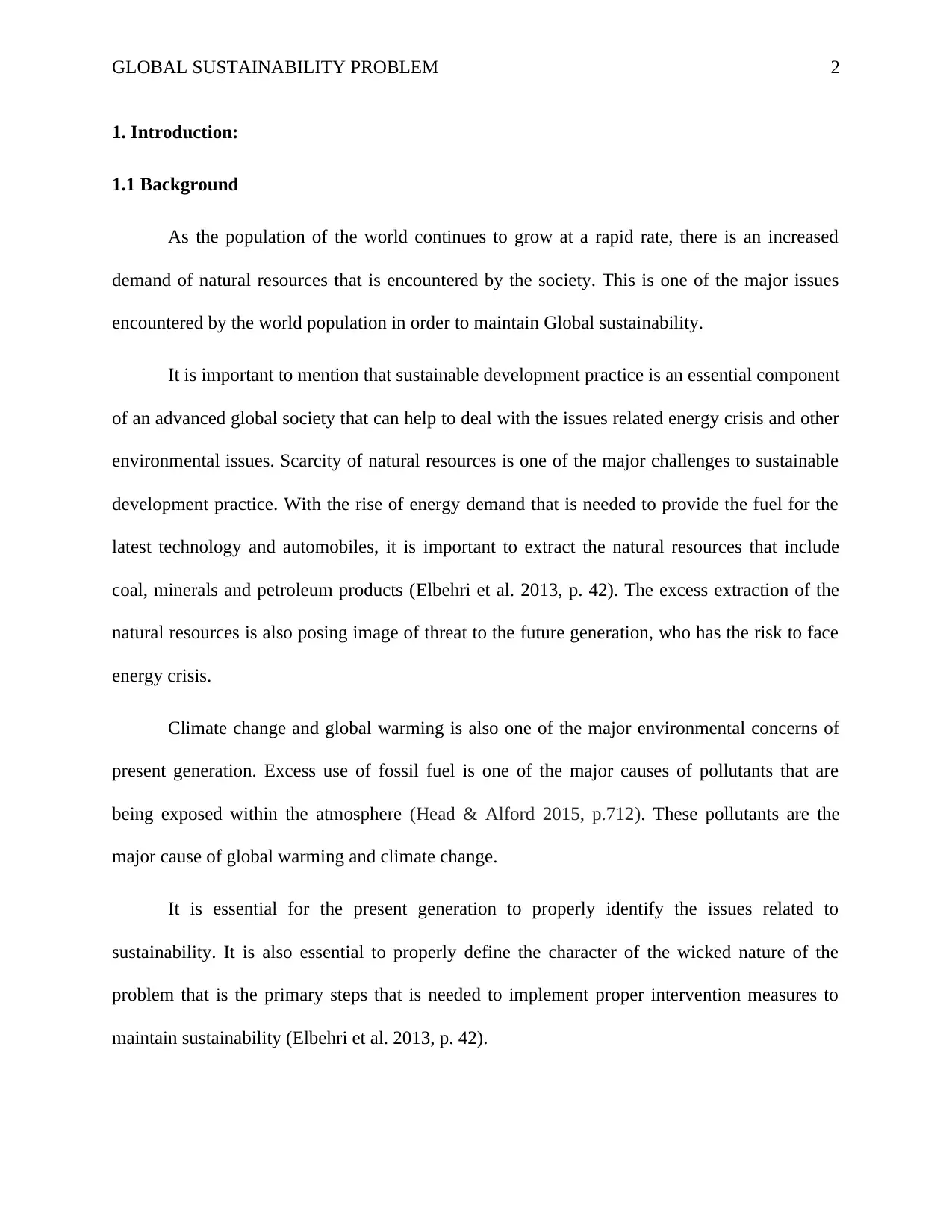
GLOBAL SUSTAINABILITY PROBLEM 2
1. Introduction:
1.1 Background
As the population of the world continues to grow at a rapid rate, there is an increased
demand of natural resources that is encountered by the society. This is one of the major issues
encountered by the world population in order to maintain Global sustainability.
It is important to mention that sustainable development practice is an essential component
of an advanced global society that can help to deal with the issues related energy crisis and other
environmental issues. Scarcity of natural resources is one of the major challenges to sustainable
development practice. With the rise of energy demand that is needed to provide the fuel for the
latest technology and automobiles, it is important to extract the natural resources that include
coal, minerals and petroleum products (Elbehri et al. 2013, p. 42). The excess extraction of the
natural resources is also posing image of threat to the future generation, who has the risk to face
energy crisis.
Climate change and global warming is also one of the major environmental concerns of
present generation. Excess use of fossil fuel is one of the major causes of pollutants that are
being exposed within the atmosphere (Head & Alford 2015, p.712). These pollutants are the
major cause of global warming and climate change.
It is essential for the present generation to properly identify the issues related to
sustainability. It is also essential to properly define the character of the wicked nature of the
problem that is the primary steps that is needed to implement proper intervention measures to
maintain sustainability (Elbehri et al. 2013, p. 42).
1. Introduction:
1.1 Background
As the population of the world continues to grow at a rapid rate, there is an increased
demand of natural resources that is encountered by the society. This is one of the major issues
encountered by the world population in order to maintain Global sustainability.
It is important to mention that sustainable development practice is an essential component
of an advanced global society that can help to deal with the issues related energy crisis and other
environmental issues. Scarcity of natural resources is one of the major challenges to sustainable
development practice. With the rise of energy demand that is needed to provide the fuel for the
latest technology and automobiles, it is important to extract the natural resources that include
coal, minerals and petroleum products (Elbehri et al. 2013, p. 42). The excess extraction of the
natural resources is also posing image of threat to the future generation, who has the risk to face
energy crisis.
Climate change and global warming is also one of the major environmental concerns of
present generation. Excess use of fossil fuel is one of the major causes of pollutants that are
being exposed within the atmosphere (Head & Alford 2015, p.712). These pollutants are the
major cause of global warming and climate change.
It is essential for the present generation to properly identify the issues related to
sustainability. It is also essential to properly define the character of the wicked nature of the
problem that is the primary steps that is needed to implement proper intervention measures to
maintain sustainability (Elbehri et al. 2013, p. 42).
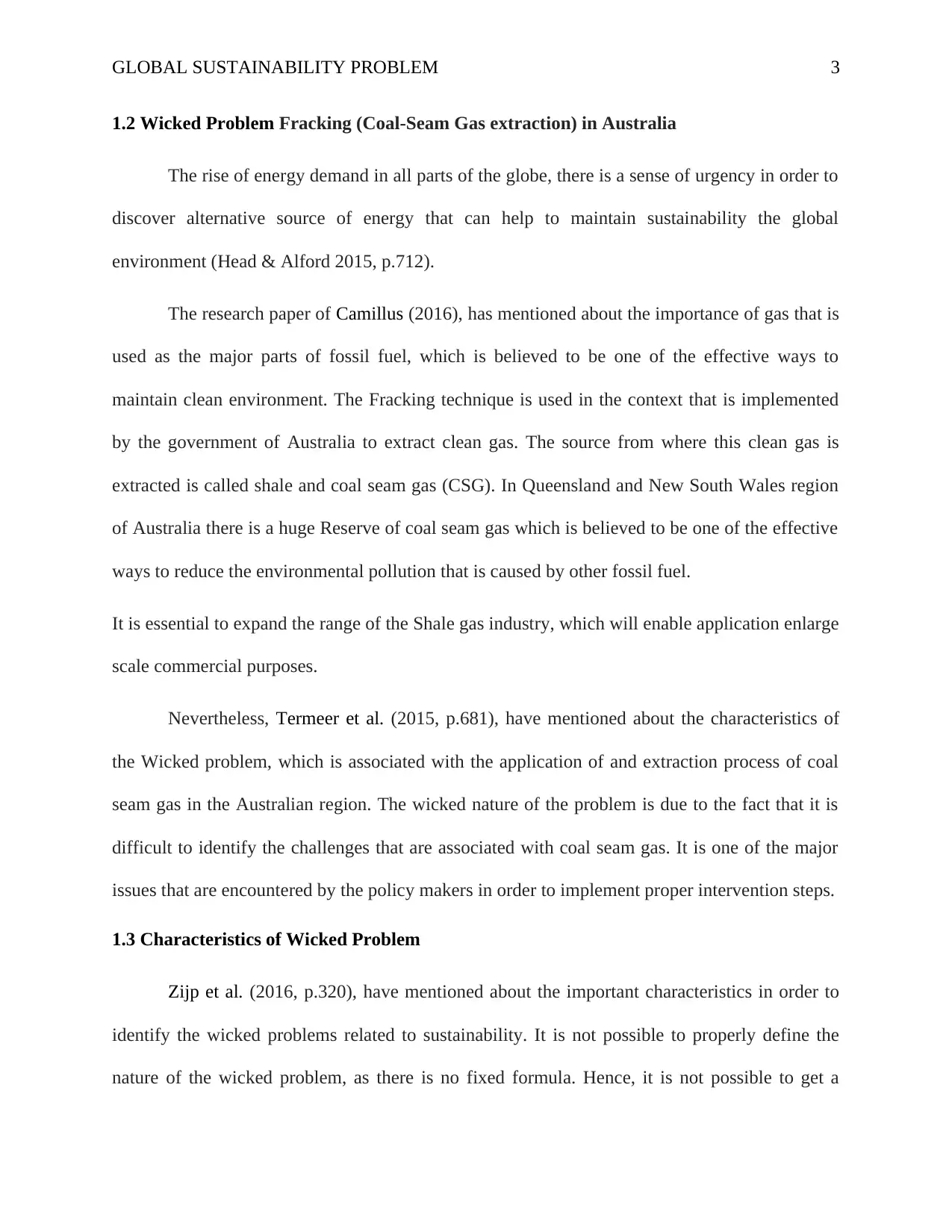
GLOBAL SUSTAINABILITY PROBLEM 3
1.2 Wicked Problem Fracking (Coal-Seam Gas extraction) in Australia
The rise of energy demand in all parts of the globe, there is a sense of urgency in order to
discover alternative source of energy that can help to maintain sustainability the global
environment (Head & Alford 2015, p.712).
The research paper of Camillus (2016), has mentioned about the importance of gas that is
used as the major parts of fossil fuel, which is believed to be one of the effective ways to
maintain clean environment. The Fracking technique is used in the context that is implemented
by the government of Australia to extract clean gas. The source from where this clean gas is
extracted is called shale and coal seam gas (CSG). In Queensland and New South Wales region
of Australia there is a huge Reserve of coal seam gas which is believed to be one of the effective
ways to reduce the environmental pollution that is caused by other fossil fuel.
It is essential to expand the range of the Shale gas industry, which will enable application enlarge
scale commercial purposes.
Nevertheless, Termeer et al. (2015, p.681), have mentioned about the characteristics of
the Wicked problem, which is associated with the application of and extraction process of coal
seam gas in the Australian region. The wicked nature of the problem is due to the fact that it is
difficult to identify the challenges that are associated with coal seam gas. It is one of the major
issues that are encountered by the policy makers in order to implement proper intervention steps.
1.3 Characteristics of Wicked Problem
Zijp et al. (2016, p.320), have mentioned about the important characteristics in order to
identify the wicked problems related to sustainability. It is not possible to properly define the
nature of the wicked problem, as there is no fixed formula. Hence, it is not possible to get a
1.2 Wicked Problem Fracking (Coal-Seam Gas extraction) in Australia
The rise of energy demand in all parts of the globe, there is a sense of urgency in order to
discover alternative source of energy that can help to maintain sustainability the global
environment (Head & Alford 2015, p.712).
The research paper of Camillus (2016), has mentioned about the importance of gas that is
used as the major parts of fossil fuel, which is believed to be one of the effective ways to
maintain clean environment. The Fracking technique is used in the context that is implemented
by the government of Australia to extract clean gas. The source from where this clean gas is
extracted is called shale and coal seam gas (CSG). In Queensland and New South Wales region
of Australia there is a huge Reserve of coal seam gas which is believed to be one of the effective
ways to reduce the environmental pollution that is caused by other fossil fuel.
It is essential to expand the range of the Shale gas industry, which will enable application enlarge
scale commercial purposes.
Nevertheless, Termeer et al. (2015, p.681), have mentioned about the characteristics of
the Wicked problem, which is associated with the application of and extraction process of coal
seam gas in the Australian region. The wicked nature of the problem is due to the fact that it is
difficult to identify the challenges that are associated with coal seam gas. It is one of the major
issues that are encountered by the policy makers in order to implement proper intervention steps.
1.3 Characteristics of Wicked Problem
Zijp et al. (2016, p.320), have mentioned about the important characteristics in order to
identify the wicked problems related to sustainability. It is not possible to properly define the
nature of the wicked problem, as there is no fixed formula. Hence, it is not possible to get a
Secure Best Marks with AI Grader
Need help grading? Try our AI Grader for instant feedback on your assignments.
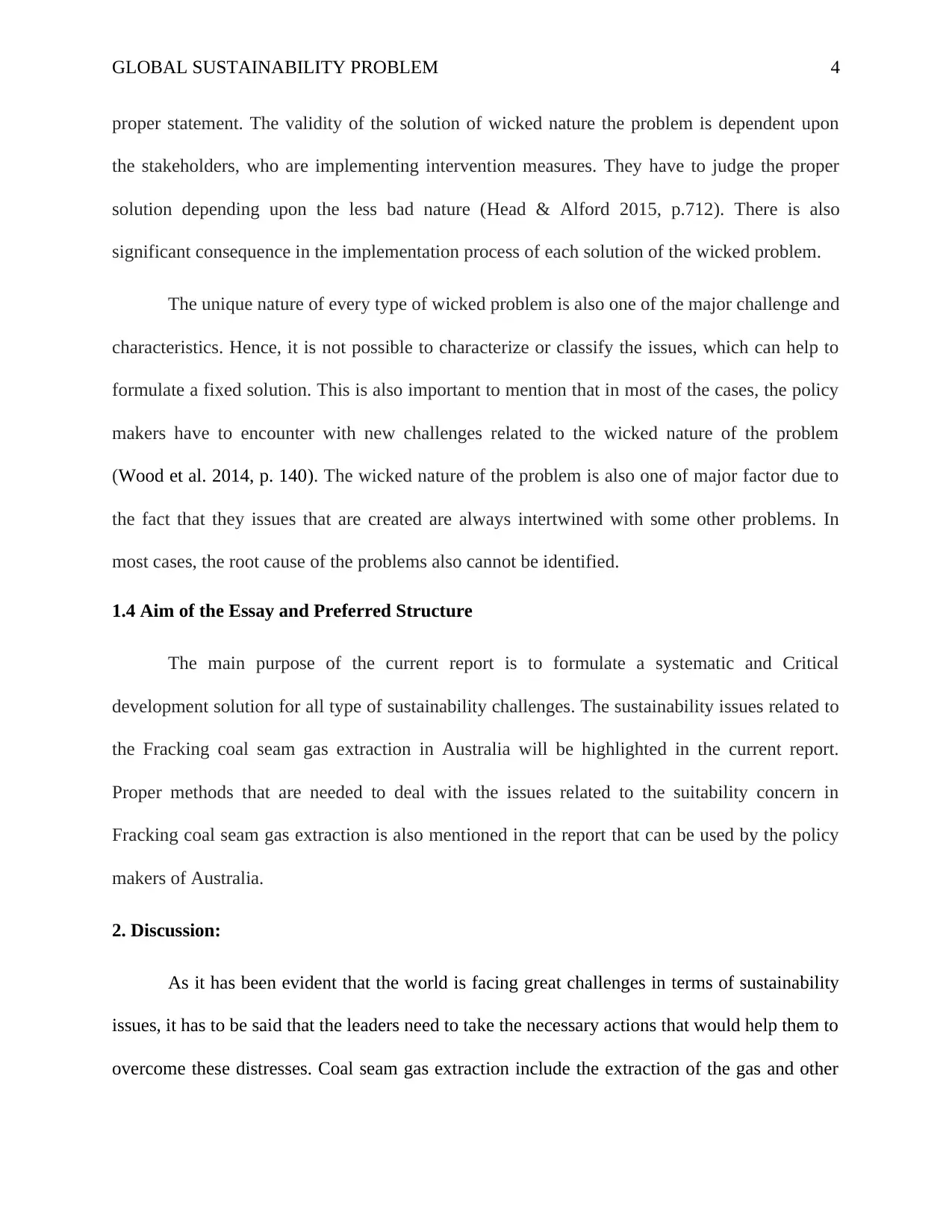
GLOBAL SUSTAINABILITY PROBLEM 4
proper statement. The validity of the solution of wicked nature the problem is dependent upon
the stakeholders, who are implementing intervention measures. They have to judge the proper
solution depending upon the less bad nature (Head & Alford 2015, p.712). There is also
significant consequence in the implementation process of each solution of the wicked problem.
The unique nature of every type of wicked problem is also one of the major challenge and
characteristics. Hence, it is not possible to characterize or classify the issues, which can help to
formulate a fixed solution. This is also important to mention that in most of the cases, the policy
makers have to encounter with new challenges related to the wicked nature of the problem
(Wood et al. 2014, p. 140). The wicked nature of the problem is also one of major factor due to
the fact that they issues that are created are always intertwined with some other problems. In
most cases, the root cause of the problems also cannot be identified.
1.4 Aim of the Essay and Preferred Structure
The main purpose of the current report is to formulate a systematic and Critical
development solution for all type of sustainability challenges. The sustainability issues related to
the Fracking coal seam gas extraction in Australia will be highlighted in the current report.
Proper methods that are needed to deal with the issues related to the suitability concern in
Fracking coal seam gas extraction is also mentioned in the report that can be used by the policy
makers of Australia.
2. Discussion:
As it has been evident that the world is facing great challenges in terms of sustainability
issues, it has to be said that the leaders need to take the necessary actions that would help them to
overcome these distresses. Coal seam gas extraction include the extraction of the gas and other
proper statement. The validity of the solution of wicked nature the problem is dependent upon
the stakeholders, who are implementing intervention measures. They have to judge the proper
solution depending upon the less bad nature (Head & Alford 2015, p.712). There is also
significant consequence in the implementation process of each solution of the wicked problem.
The unique nature of every type of wicked problem is also one of the major challenge and
characteristics. Hence, it is not possible to characterize or classify the issues, which can help to
formulate a fixed solution. This is also important to mention that in most of the cases, the policy
makers have to encounter with new challenges related to the wicked nature of the problem
(Wood et al. 2014, p. 140). The wicked nature of the problem is also one of major factor due to
the fact that they issues that are created are always intertwined with some other problems. In
most cases, the root cause of the problems also cannot be identified.
1.4 Aim of the Essay and Preferred Structure
The main purpose of the current report is to formulate a systematic and Critical
development solution for all type of sustainability challenges. The sustainability issues related to
the Fracking coal seam gas extraction in Australia will be highlighted in the current report.
Proper methods that are needed to deal with the issues related to the suitability concern in
Fracking coal seam gas extraction is also mentioned in the report that can be used by the policy
makers of Australia.
2. Discussion:
As it has been evident that the world is facing great challenges in terms of sustainability
issues, it has to be said that the leaders need to take the necessary actions that would help them to
overcome these distresses. Coal seam gas extraction include the extraction of the gas and other
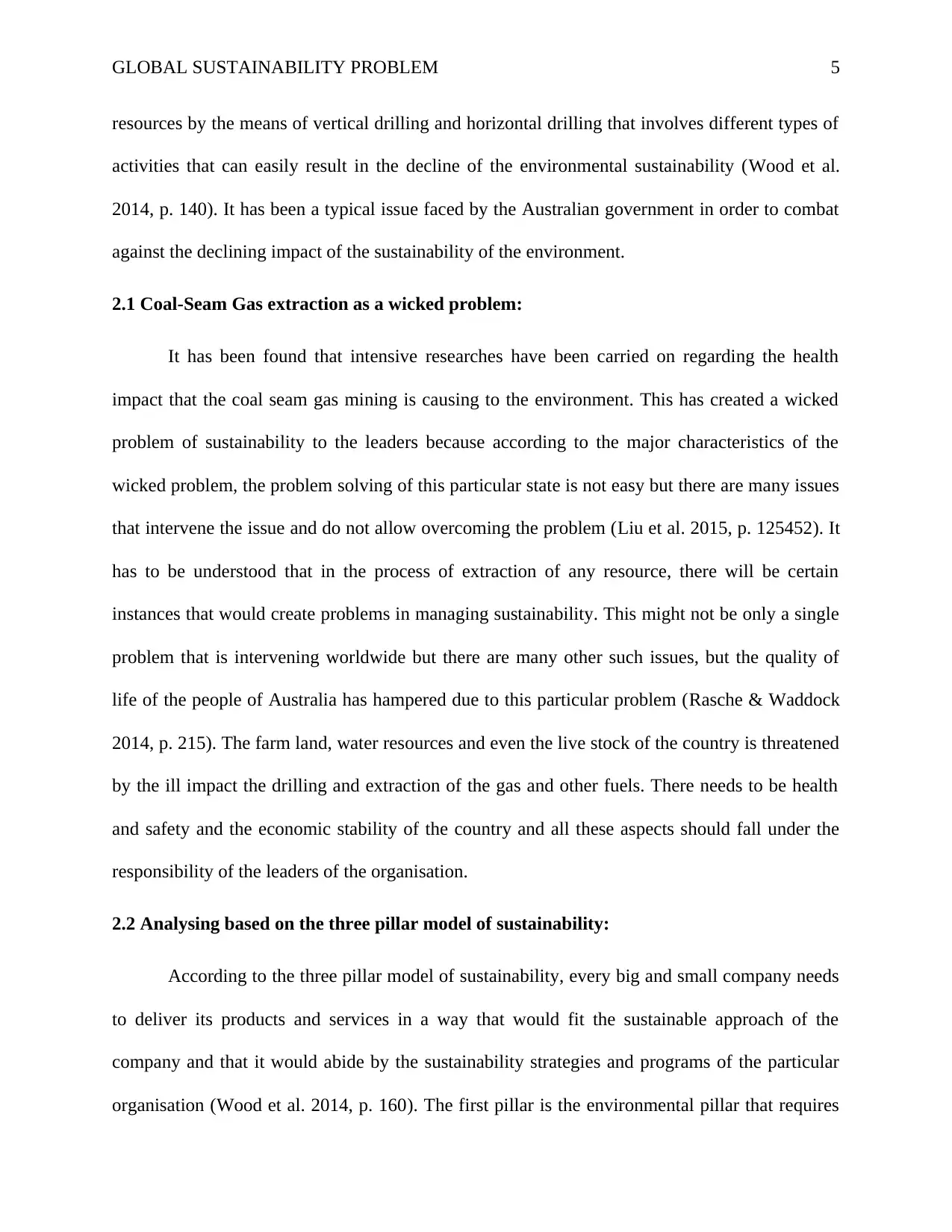
GLOBAL SUSTAINABILITY PROBLEM 5
resources by the means of vertical drilling and horizontal drilling that involves different types of
activities that can easily result in the decline of the environmental sustainability (Wood et al.
2014, p. 140). It has been a typical issue faced by the Australian government in order to combat
against the declining impact of the sustainability of the environment.
2.1 Coal-Seam Gas extraction as a wicked problem:
It has been found that intensive researches have been carried on regarding the health
impact that the coal seam gas mining is causing to the environment. This has created a wicked
problem of sustainability to the leaders because according to the major characteristics of the
wicked problem, the problem solving of this particular state is not easy but there are many issues
that intervene the issue and do not allow overcoming the problem (Liu et al. 2015, p. 125452). It
has to be understood that in the process of extraction of any resource, there will be certain
instances that would create problems in managing sustainability. This might not be only a single
problem that is intervening worldwide but there are many other such issues, but the quality of
life of the people of Australia has hampered due to this particular problem (Rasche & Waddock
2014, p. 215). The farm land, water resources and even the live stock of the country is threatened
by the ill impact the drilling and extraction of the gas and other fuels. There needs to be health
and safety and the economic stability of the country and all these aspects should fall under the
responsibility of the leaders of the organisation.
2.2 Analysing based on the three pillar model of sustainability:
According to the three pillar model of sustainability, every big and small company needs
to deliver its products and services in a way that would fit the sustainable approach of the
company and that it would abide by the sustainability strategies and programs of the particular
organisation (Wood et al. 2014, p. 160). The first pillar is the environmental pillar that requires
resources by the means of vertical drilling and horizontal drilling that involves different types of
activities that can easily result in the decline of the environmental sustainability (Wood et al.
2014, p. 140). It has been a typical issue faced by the Australian government in order to combat
against the declining impact of the sustainability of the environment.
2.1 Coal-Seam Gas extraction as a wicked problem:
It has been found that intensive researches have been carried on regarding the health
impact that the coal seam gas mining is causing to the environment. This has created a wicked
problem of sustainability to the leaders because according to the major characteristics of the
wicked problem, the problem solving of this particular state is not easy but there are many issues
that intervene the issue and do not allow overcoming the problem (Liu et al. 2015, p. 125452). It
has to be understood that in the process of extraction of any resource, there will be certain
instances that would create problems in managing sustainability. This might not be only a single
problem that is intervening worldwide but there are many other such issues, but the quality of
life of the people of Australia has hampered due to this particular problem (Rasche & Waddock
2014, p. 215). The farm land, water resources and even the live stock of the country is threatened
by the ill impact the drilling and extraction of the gas and other fuels. There needs to be health
and safety and the economic stability of the country and all these aspects should fall under the
responsibility of the leaders of the organisation.
2.2 Analysing based on the three pillar model of sustainability:
According to the three pillar model of sustainability, every big and small company needs
to deliver its products and services in a way that would fit the sustainable approach of the
company and that it would abide by the sustainability strategies and programs of the particular
organisation (Wood et al. 2014, p. 160). The first pillar is the environmental pillar that requires
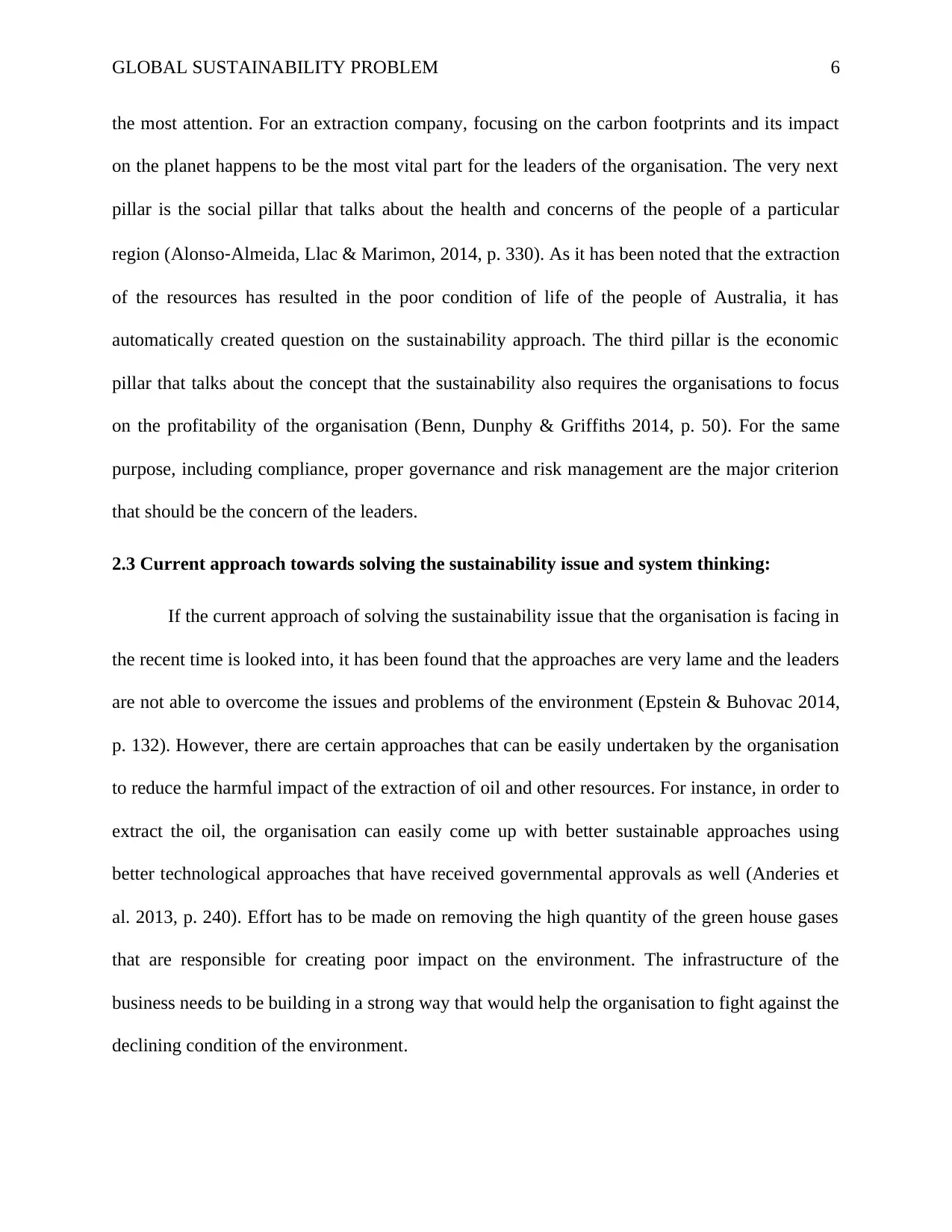
GLOBAL SUSTAINABILITY PROBLEM 6
the most attention. For an extraction company, focusing on the carbon footprints and its impact
on the planet happens to be the most vital part for the leaders of the organisation. The very next
pillar is the social pillar that talks about the health and concerns of the people of a particular
region (Alonso‐Almeida, Llac & Marimon, 2014, p. 330). As it has been noted that the extraction
of the resources has resulted in the poor condition of life of the people of Australia, it has
automatically created question on the sustainability approach. The third pillar is the economic
pillar that talks about the concept that the sustainability also requires the organisations to focus
on the profitability of the organisation (Benn, Dunphy & Griffiths 2014, p. 50). For the same
purpose, including compliance, proper governance and risk management are the major criterion
that should be the concern of the leaders.
2.3 Current approach towards solving the sustainability issue and system thinking:
If the current approach of solving the sustainability issue that the organisation is facing in
the recent time is looked into, it has been found that the approaches are very lame and the leaders
are not able to overcome the issues and problems of the environment (Epstein & Buhovac 2014,
p. 132). However, there are certain approaches that can be easily undertaken by the organisation
to reduce the harmful impact of the extraction of oil and other resources. For instance, in order to
extract the oil, the organisation can easily come up with better sustainable approaches using
better technological approaches that have received governmental approvals as well (Anderies et
al. 2013, p. 240). Effort has to be made on removing the high quantity of the green house gases
that are responsible for creating poor impact on the environment. The infrastructure of the
business needs to be building in a strong way that would help the organisation to fight against the
declining condition of the environment.
the most attention. For an extraction company, focusing on the carbon footprints and its impact
on the planet happens to be the most vital part for the leaders of the organisation. The very next
pillar is the social pillar that talks about the health and concerns of the people of a particular
region (Alonso‐Almeida, Llac & Marimon, 2014, p. 330). As it has been noted that the extraction
of the resources has resulted in the poor condition of life of the people of Australia, it has
automatically created question on the sustainability approach. The third pillar is the economic
pillar that talks about the concept that the sustainability also requires the organisations to focus
on the profitability of the organisation (Benn, Dunphy & Griffiths 2014, p. 50). For the same
purpose, including compliance, proper governance and risk management are the major criterion
that should be the concern of the leaders.
2.3 Current approach towards solving the sustainability issue and system thinking:
If the current approach of solving the sustainability issue that the organisation is facing in
the recent time is looked into, it has been found that the approaches are very lame and the leaders
are not able to overcome the issues and problems of the environment (Epstein & Buhovac 2014,
p. 132). However, there are certain approaches that can be easily undertaken by the organisation
to reduce the harmful impact of the extraction of oil and other resources. For instance, in order to
extract the oil, the organisation can easily come up with better sustainable approaches using
better technological approaches that have received governmental approvals as well (Anderies et
al. 2013, p. 240). Effort has to be made on removing the high quantity of the green house gases
that are responsible for creating poor impact on the environment. The infrastructure of the
business needs to be building in a strong way that would help the organisation to fight against the
declining condition of the environment.
Paraphrase This Document
Need a fresh take? Get an instant paraphrase of this document with our AI Paraphraser
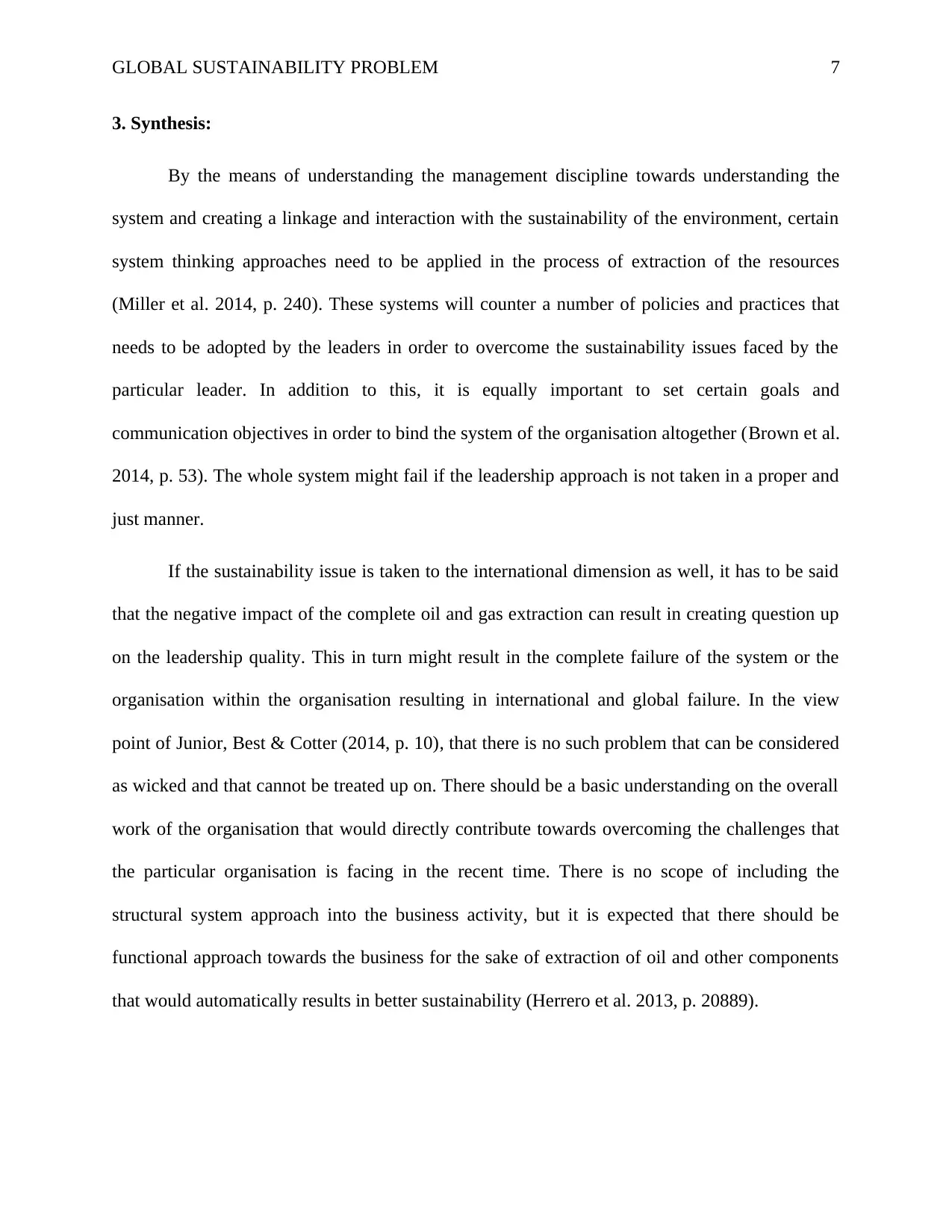
GLOBAL SUSTAINABILITY PROBLEM 7
3. Synthesis:
By the means of understanding the management discipline towards understanding the
system and creating a linkage and interaction with the sustainability of the environment, certain
system thinking approaches need to be applied in the process of extraction of the resources
(Miller et al. 2014, p. 240). These systems will counter a number of policies and practices that
needs to be adopted by the leaders in order to overcome the sustainability issues faced by the
particular leader. In addition to this, it is equally important to set certain goals and
communication objectives in order to bind the system of the organisation altogether (Brown et al.
2014, p. 53). The whole system might fail if the leadership approach is not taken in a proper and
just manner.
If the sustainability issue is taken to the international dimension as well, it has to be said
that the negative impact of the complete oil and gas extraction can result in creating question up
on the leadership quality. This in turn might result in the complete failure of the system or the
organisation within the organisation resulting in international and global failure. In the view
point of Junior, Best & Cotter (2014, p. 10), that there is no such problem that can be considered
as wicked and that cannot be treated up on. There should be a basic understanding on the overall
work of the organisation that would directly contribute towards overcoming the challenges that
the particular organisation is facing in the recent time. There is no scope of including the
structural system approach into the business activity, but it is expected that there should be
functional approach towards the business for the sake of extraction of oil and other components
that would automatically results in better sustainability (Herrero et al. 2013, p. 20889).
3. Synthesis:
By the means of understanding the management discipline towards understanding the
system and creating a linkage and interaction with the sustainability of the environment, certain
system thinking approaches need to be applied in the process of extraction of the resources
(Miller et al. 2014, p. 240). These systems will counter a number of policies and practices that
needs to be adopted by the leaders in order to overcome the sustainability issues faced by the
particular leader. In addition to this, it is equally important to set certain goals and
communication objectives in order to bind the system of the organisation altogether (Brown et al.
2014, p. 53). The whole system might fail if the leadership approach is not taken in a proper and
just manner.
If the sustainability issue is taken to the international dimension as well, it has to be said
that the negative impact of the complete oil and gas extraction can result in creating question up
on the leadership quality. This in turn might result in the complete failure of the system or the
organisation within the organisation resulting in international and global failure. In the view
point of Junior, Best & Cotter (2014, p. 10), that there is no such problem that can be considered
as wicked and that cannot be treated up on. There should be a basic understanding on the overall
work of the organisation that would directly contribute towards overcoming the challenges that
the particular organisation is facing in the recent time. There is no scope of including the
structural system approach into the business activity, but it is expected that there should be
functional approach towards the business for the sake of extraction of oil and other components
that would automatically results in better sustainability (Herrero et al. 2013, p. 20889).
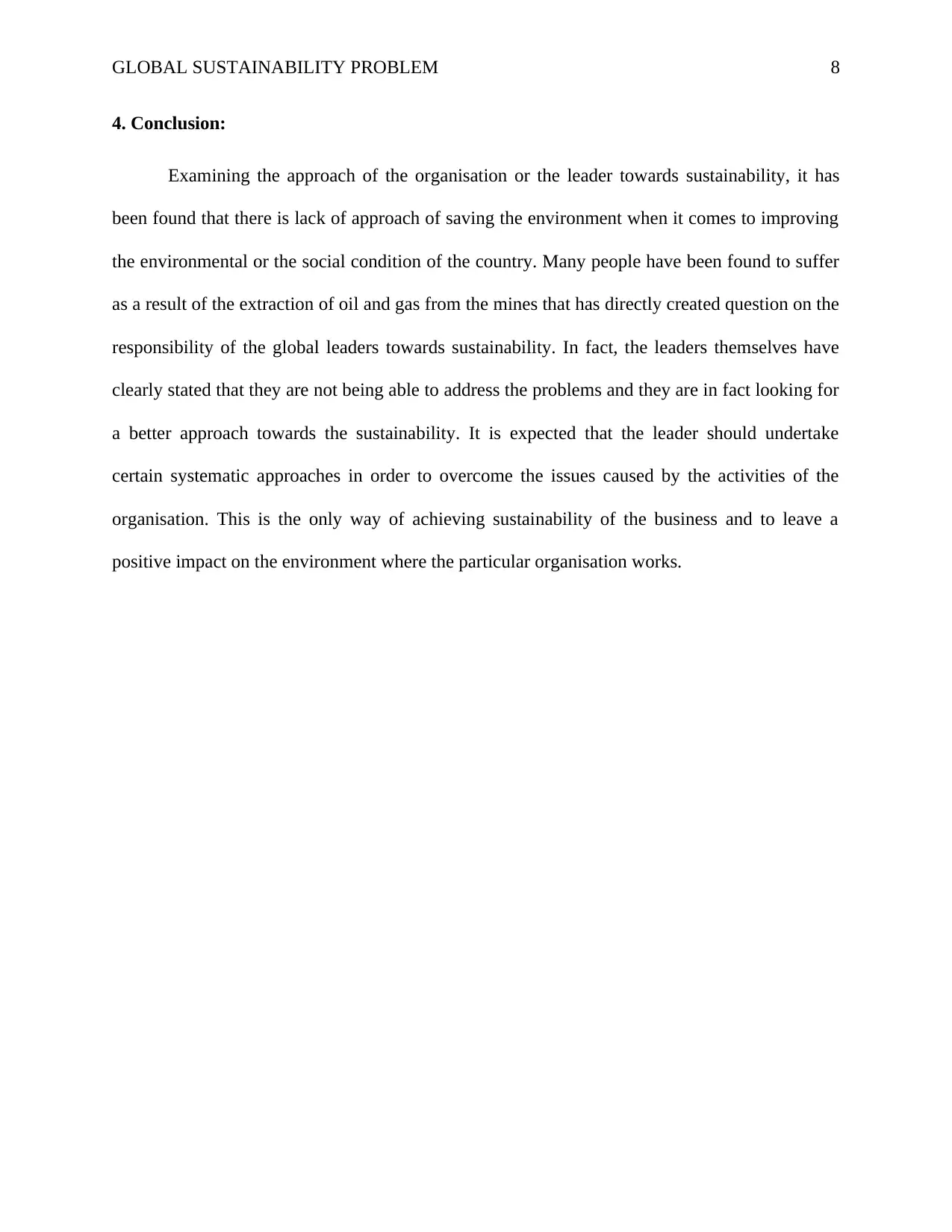
GLOBAL SUSTAINABILITY PROBLEM 8
4. Conclusion:
Examining the approach of the organisation or the leader towards sustainability, it has
been found that there is lack of approach of saving the environment when it comes to improving
the environmental or the social condition of the country. Many people have been found to suffer
as a result of the extraction of oil and gas from the mines that has directly created question on the
responsibility of the global leaders towards sustainability. In fact, the leaders themselves have
clearly stated that they are not being able to address the problems and they are in fact looking for
a better approach towards the sustainability. It is expected that the leader should undertake
certain systematic approaches in order to overcome the issues caused by the activities of the
organisation. This is the only way of achieving sustainability of the business and to leave a
positive impact on the environment where the particular organisation works.
4. Conclusion:
Examining the approach of the organisation or the leader towards sustainability, it has
been found that there is lack of approach of saving the environment when it comes to improving
the environmental or the social condition of the country. Many people have been found to suffer
as a result of the extraction of oil and gas from the mines that has directly created question on the
responsibility of the global leaders towards sustainability. In fact, the leaders themselves have
clearly stated that they are not being able to address the problems and they are in fact looking for
a better approach towards the sustainability. It is expected that the leader should undertake
certain systematic approaches in order to overcome the issues caused by the activities of the
organisation. This is the only way of achieving sustainability of the business and to leave a
positive impact on the environment where the particular organisation works.
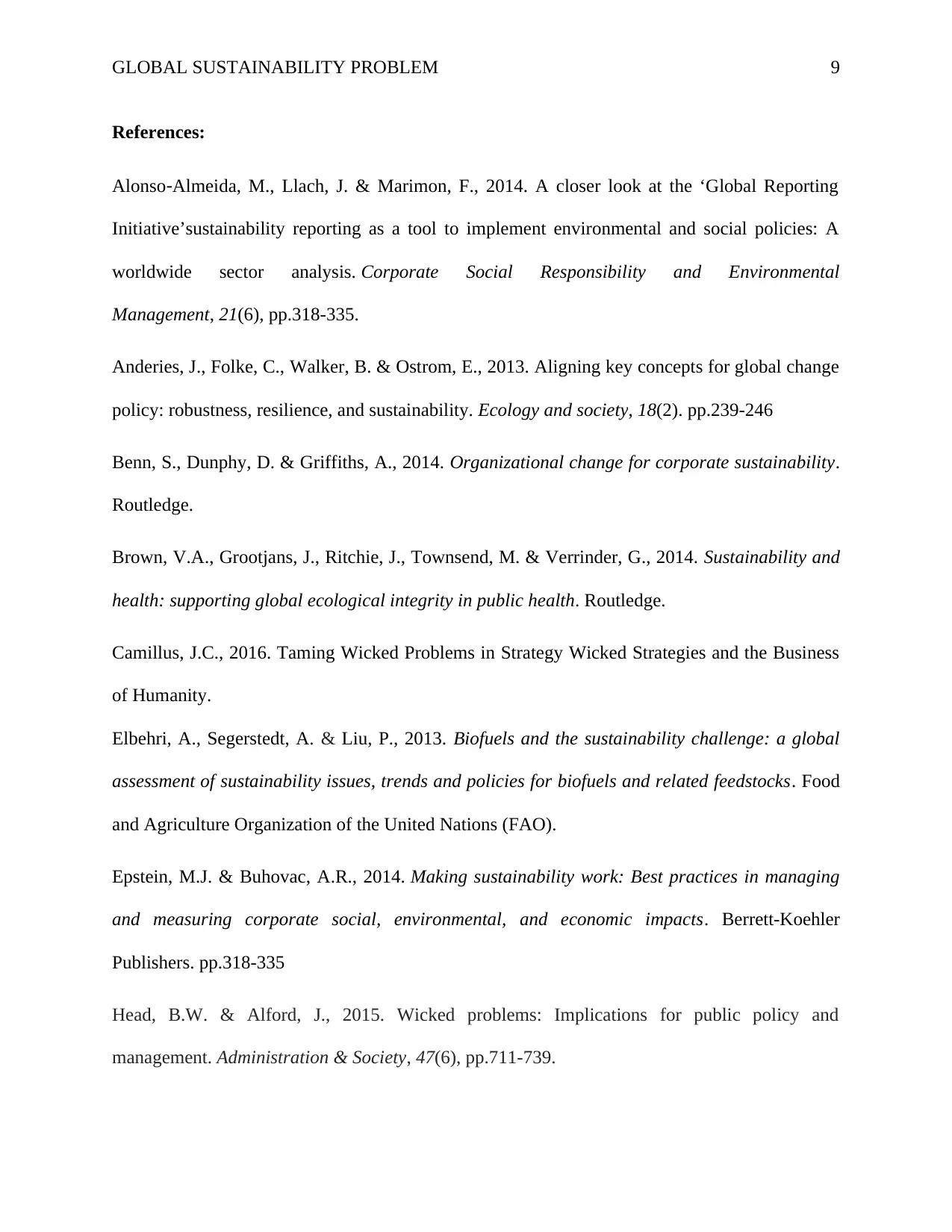
GLOBAL SUSTAINABILITY PROBLEM 9
References:
Alonso‐Almeida, M., Llach, J. & Marimon, F., 2014. A closer look at the ‘Global Reporting
Initiative’sustainability reporting as a tool to implement environmental and social policies: A
worldwide sector analysis. Corporate Social Responsibility and Environmental
Management, 21(6), pp.318-335.
Anderies, J., Folke, C., Walker, B. & Ostrom, E., 2013. Aligning key concepts for global change
policy: robustness, resilience, and sustainability. Ecology and society, 18(2). pp.239-246
Benn, S., Dunphy, D. & Griffiths, A., 2014. Organizational change for corporate sustainability.
Routledge.
Brown, V.A., Grootjans, J., Ritchie, J., Townsend, M. & Verrinder, G., 2014. Sustainability and
health: supporting global ecological integrity in public health. Routledge.
Camillus, J.C., 2016. Taming Wicked Problems in Strategy Wicked Strategies and the Business
of Humanity.
Elbehri, A., Segerstedt, A. & Liu, P., 2013. Biofuels and the sustainability challenge: a global
assessment of sustainability issues, trends and policies for biofuels and related feedstocks. Food
and Agriculture Organization of the United Nations (FAO).
Epstein, M.J. & Buhovac, A.R., 2014. Making sustainability work: Best practices in managing
and measuring corporate social, environmental, and economic impacts. Berrett-Koehler
Publishers. pp.318-335
Head, B.W. & Alford, J., 2015. Wicked problems: Implications for public policy and
management. Administration & Society, 47(6), pp.711-739.
References:
Alonso‐Almeida, M., Llach, J. & Marimon, F., 2014. A closer look at the ‘Global Reporting
Initiative’sustainability reporting as a tool to implement environmental and social policies: A
worldwide sector analysis. Corporate Social Responsibility and Environmental
Management, 21(6), pp.318-335.
Anderies, J., Folke, C., Walker, B. & Ostrom, E., 2013. Aligning key concepts for global change
policy: robustness, resilience, and sustainability. Ecology and society, 18(2). pp.239-246
Benn, S., Dunphy, D. & Griffiths, A., 2014. Organizational change for corporate sustainability.
Routledge.
Brown, V.A., Grootjans, J., Ritchie, J., Townsend, M. & Verrinder, G., 2014. Sustainability and
health: supporting global ecological integrity in public health. Routledge.
Camillus, J.C., 2016. Taming Wicked Problems in Strategy Wicked Strategies and the Business
of Humanity.
Elbehri, A., Segerstedt, A. & Liu, P., 2013. Biofuels and the sustainability challenge: a global
assessment of sustainability issues, trends and policies for biofuels and related feedstocks. Food
and Agriculture Organization of the United Nations (FAO).
Epstein, M.J. & Buhovac, A.R., 2014. Making sustainability work: Best practices in managing
and measuring corporate social, environmental, and economic impacts. Berrett-Koehler
Publishers. pp.318-335
Head, B.W. & Alford, J., 2015. Wicked problems: Implications for public policy and
management. Administration & Society, 47(6), pp.711-739.
Secure Best Marks with AI Grader
Need help grading? Try our AI Grader for instant feedback on your assignments.
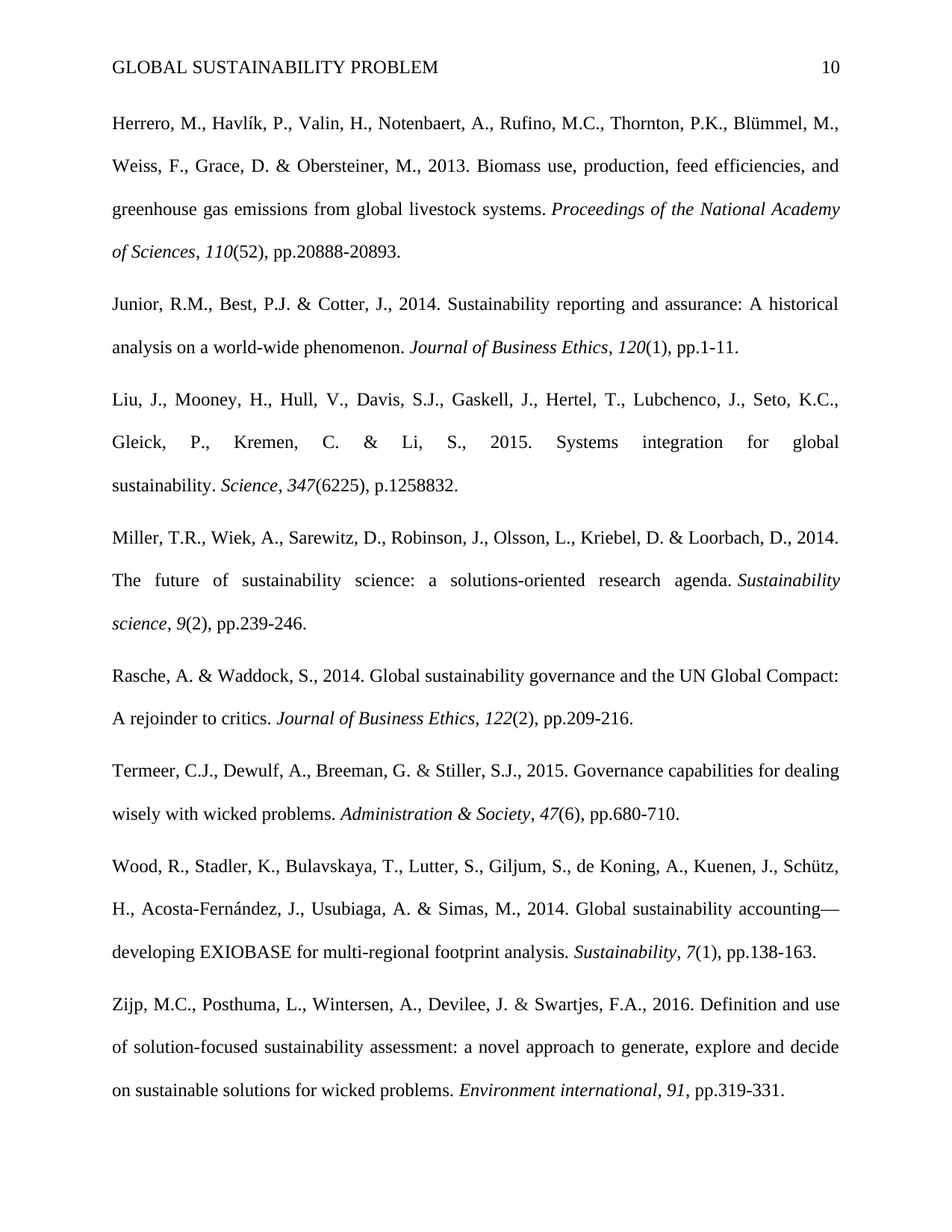
GLOBAL SUSTAINABILITY PROBLEM 10
Herrero, M., Havlík, P., Valin, H., Notenbaert, A., Rufino, M.C., Thornton, P.K., Blümmel, M.,
Weiss, F., Grace, D. & Obersteiner, M., 2013. Biomass use, production, feed efficiencies, and
greenhouse gas emissions from global livestock systems. Proceedings of the National Academy
of Sciences, 110(52), pp.20888-20893.
Junior, R.M., Best, P.J. & Cotter, J., 2014. Sustainability reporting and assurance: A historical
analysis on a world-wide phenomenon. Journal of Business Ethics, 120(1), pp.1-11.
Liu, J., Mooney, H., Hull, V., Davis, S.J., Gaskell, J., Hertel, T., Lubchenco, J., Seto, K.C.,
Gleick, P., Kremen, C. & Li, S., 2015. Systems integration for global
sustainability. Science, 347(6225), p.1258832.
Miller, T.R., Wiek, A., Sarewitz, D., Robinson, J., Olsson, L., Kriebel, D. & Loorbach, D., 2014.
The future of sustainability science: a solutions-oriented research agenda. Sustainability
science, 9(2), pp.239-246.
Rasche, A. & Waddock, S., 2014. Global sustainability governance and the UN Global Compact:
A rejoinder to critics. Journal of Business Ethics, 122(2), pp.209-216.
Termeer, C.J., Dewulf, A., Breeman, G. & Stiller, S.J., 2015. Governance capabilities for dealing
wisely with wicked problems. Administration & Society, 47(6), pp.680-710.
Wood, R., Stadler, K., Bulavskaya, T., Lutter, S., Giljum, S., de Koning, A., Kuenen, J., Schütz,
H., Acosta-Fernández, J., Usubiaga, A. & Simas, M., 2014. Global sustainability accounting—
developing EXIOBASE for multi-regional footprint analysis. Sustainability, 7(1), pp.138-163.
Zijp, M.C., Posthuma, L., Wintersen, A., Devilee, J. & Swartjes, F.A., 2016. Definition and use
of solution-focused sustainability assessment: a novel approach to generate, explore and decide
on sustainable solutions for wicked problems. Environment international, 91, pp.319-331.
Herrero, M., Havlík, P., Valin, H., Notenbaert, A., Rufino, M.C., Thornton, P.K., Blümmel, M.,
Weiss, F., Grace, D. & Obersteiner, M., 2013. Biomass use, production, feed efficiencies, and
greenhouse gas emissions from global livestock systems. Proceedings of the National Academy
of Sciences, 110(52), pp.20888-20893.
Junior, R.M., Best, P.J. & Cotter, J., 2014. Sustainability reporting and assurance: A historical
analysis on a world-wide phenomenon. Journal of Business Ethics, 120(1), pp.1-11.
Liu, J., Mooney, H., Hull, V., Davis, S.J., Gaskell, J., Hertel, T., Lubchenco, J., Seto, K.C.,
Gleick, P., Kremen, C. & Li, S., 2015. Systems integration for global
sustainability. Science, 347(6225), p.1258832.
Miller, T.R., Wiek, A., Sarewitz, D., Robinson, J., Olsson, L., Kriebel, D. & Loorbach, D., 2014.
The future of sustainability science: a solutions-oriented research agenda. Sustainability
science, 9(2), pp.239-246.
Rasche, A. & Waddock, S., 2014. Global sustainability governance and the UN Global Compact:
A rejoinder to critics. Journal of Business Ethics, 122(2), pp.209-216.
Termeer, C.J., Dewulf, A., Breeman, G. & Stiller, S.J., 2015. Governance capabilities for dealing
wisely with wicked problems. Administration & Society, 47(6), pp.680-710.
Wood, R., Stadler, K., Bulavskaya, T., Lutter, S., Giljum, S., de Koning, A., Kuenen, J., Schütz,
H., Acosta-Fernández, J., Usubiaga, A. & Simas, M., 2014. Global sustainability accounting—
developing EXIOBASE for multi-regional footprint analysis. Sustainability, 7(1), pp.138-163.
Zijp, M.C., Posthuma, L., Wintersen, A., Devilee, J. & Swartjes, F.A., 2016. Definition and use
of solution-focused sustainability assessment: a novel approach to generate, explore and decide
on sustainable solutions for wicked problems. Environment international, 91, pp.319-331.
1 out of 11
Related Documents
Your All-in-One AI-Powered Toolkit for Academic Success.
+13062052269
info@desklib.com
Available 24*7 on WhatsApp / Email
![[object Object]](/_next/static/media/star-bottom.7253800d.svg)
Unlock your academic potential
© 2024 | Zucol Services PVT LTD | All rights reserved.





